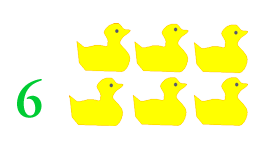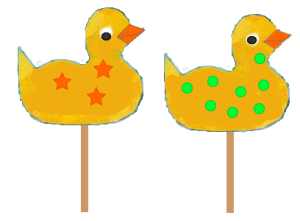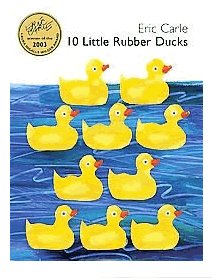Combine math and literature with Eric Carle’s book, Ten Little Rubber Ducks.
It’s based on a true story about bathtub toys that fell off a container ship and floated to various places.
This delightful tale is another example of Carle’s colourful tissue paper collage style. The story begins in the factory where the ducks are made. They’re then loaded on a freighter but during stormy weather ten of little rubber ducks fall into the ocean and float away.
Try the activities below with your students to help them practice counting sets of ducks and to learn how to use ordinal numbers.
Practice counting
Have the children cut sections of ducks out of the free duck picture handout, glue them to their papers and then print the correct number of ducks beside each group. The children can then use crayons or felts to add words, water, plants, or anything they like to their pictures.
 Make a counting book
Make a counting book
- Read Ten Little Rubber Ducks right through on the first day.
- On the second day read the book and talk about the story and the pictures.
- On day three, count how many ducks are on each page.
- Choose a number and have the children create two or three class books based on “Ten Little Rubber Ducks”. In a book called “5 Little Puppy Dogs”, for instance, each child in the group can make a page with 5 puppies going to a different place.
- As you read the class book over and over, have the children count the five puppies on each page.
- Don’t make the books too long or the kids may lose interest. Vary the number of class books you make depending on the number of children you are working with.
- In a class of twenty children, for instance, ten children might create pages for a book about five puppies and the other ten children may create pages for a book about five kittens, etcetera.
Teach ordinal numbers
The 10 little rubber ducks meet various animals on their journey and the happy 10th duck meets a mother duck with her brood and follow them to her nest.
Read the book over and over to help the children get used to hearing ordinal numbers. Many young children are very familiar with the terms, “first” and “last” but not too many know how to correctly use the terms, second, third, fourth, etcetera.
Using games to reinforce the concepts of ordinal numbers
- Make 10 simple rubber duck puppets with ducks cut out of yellow construction paper, stickers, and popsicle sticks (see picture above).
- Make each duck different
- Tape the popsicle sticks high up on the cut out ducks to keep the paper from drooping over.
Musical ducks ordinal numbers game
Play games with the simple duck puppets mentioned above to reinforce ordinal numbers.
- Have five children each hold a different duck puppet and walk around the middle of the carpet.
- Play music and then turn it off (like musical chairs).
- If you choose a song the children already know. the rest of the children watching from the outside of the carpet can sing too.
- When the music is turned off the children with the ducks sit in a row on the carpet and hold their ducks up.
- Use pieces of tape on the rug to help the children know where to sit.
- Every one else chants along with the teacher’s guidance (touch each one)… “The duck with the green dots is first, the duck with the orange stars is second, the duck with ….” until you get to the last duck.
- Children trade places and five more children get to walk around with the ducks.
- Increase to six, then seven, then eight, until the children are familiar with the ordinal terms to ten.
Assessing ordinal number sense
- Test a child’s knowledge of ordinal numbers by lining up five different colored plastic toys and placing them in a row.
- Tell the child that the toys are running in a race to the plastic map or book or whatever you choose.
- Then ask the child to touch the one that is first.
- Many young children can do this correctly.
- Then ask the child to touch the fourth one, the fifth one, the second one, etcetera.
- Do not say them in order. You can quickly see which children have a good understanding of ordinal numbers and which ones need to play with the concept more.

